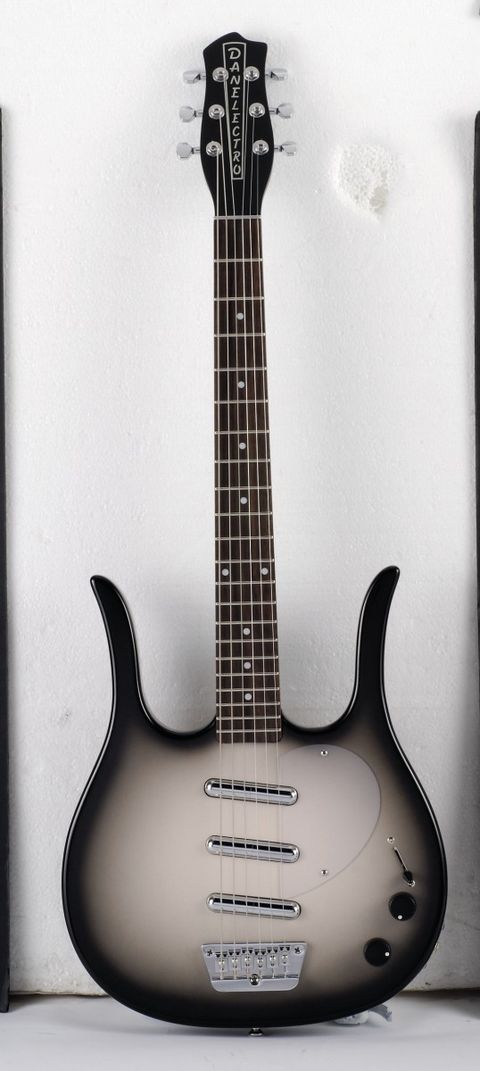This year Danelectro has turned its attention to one of the most unusual guitar designs ever: the Longhorn.
Here, Danelectro gives us a more complement of 21 medium frets.
No left-handers are available, although the symmetrical lyre-shaped body outline and central strap button placement are leftie friendly should you wish to flip the guitar around Jimi-style.
The guitar boasts typical Danelectro features including the arguably wear-prone aluminium nuts and transparent plastic scratchplates secured by just a pair of screws.
This results in the scratchplate flapping around and coming away from the body a little, but on the plus side it allows for plenty of picks to be stowed around the edges when it comes to gigging the things.
Body construction is identical to the updated '56 Pro, with a laminate frame capped with Masonite (hardboard) top and back.
Overview
Resplendent in a two-tone Blackburst paint job that fades to light grey at the centre, the Longhorn guitar's hue at distance is somewhat reminiscent of Gibson's late 1970s Silverburst finish, albeit without the metallic paint.
Initial impressions when picking it up are of a guitar with an almost three-quarter like feel, as the combination of those elongated horns and the deep bridge placement makes this a very compact electric indeed.
Having said that, the Gibson-like scale length - unusually paired here with just 21, rather than 22 frets - lends the Longhorn a deceptively bend-friendly string tension.
The '56 Pro may have had a longer, more typically Fender-like, scale length, but the dimensions of Longhorn's gloss-black painted neck are virtually identical to its predecessor: a plump 'D'-shape that fills the palm nicely.
Again, like the '56 Pro, the headstock shape is a non-symmetrical variation on the classic 'Coke Bottle' outline, which echoed the single cutaway outline of the '56 Pro nicely but doesn't quite complement the symmetry of the Longhorn design in the same way.
Six sealed chrome Gotoh-a-likes anchor the strings at the headstock, while at the bridge end intonation woes are averted to a large degree by the presence of six individually adjustable bridge saddles.
Surely only the staunchest Danelectro purists will lament the passing of the one-piece rosewood saddle alternative.
Electronics-wise, a trio of Danelectro's new hotter Alnico Lipstick single-coils and a five-way pickup selector promise more sonic versatility than the '56 Pro.
Sounds
We're guessing that not many players strap on a Danelectro with the expectation of a sumptuous blues tone or warm jazz.
Jon Spencer Blues Explosion in spades, maybe, but that's obviously a different kettle of fish altogether.
Beginning with the Longhorn guitar and a clean amp tone, we are presented with a range of bright, biting clean voices perfect for sixties-influenced pop.
Although the addition of a five-way pickup selector might hint at a certain Stratocaster-ish character, the combination of a shorter scale length than the twangier '56 Pro and series 'in-between' positions makes for a different animal indeed.
The addition of the middle Lipstick single-coil gives access to one of the most pleasing sounds in the Danelectro catalogue.
Recalling the sound of a single pickup double-cutaway Dano as wielded by a certain Mr Page, the middle position on the five-way blade selector is a percussive, bright-yet-full voice which works very well indeed for rhythm guitar across a broad range of musical genres, with the possible exception of death metal.
Wind up the gain and the Longhorn's naturally short decay and brashness make it perfect for garage rock riffing played with bags of attitude and right-hand aggression.
The Lipstick pickups tend to respond best either to AC30-style grit or fuzzy dirtbox distortion, rather than the dirty channel of a modern high-gain amplifier.

